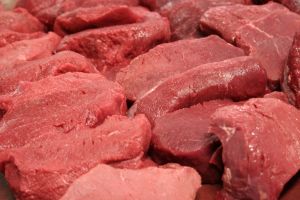Question:
I have a dog and 2 cats on a homemade raw diet made under recommendation of a holistic vet. I grind whole chickens with bone and skin, raw veggies and add vitamins and essential fatty acids. I have been doing this for about 3 years and my pets have well formed stools and shiny coats. My dog started all of this because of skin allergies, which since have disappeared. What is your advice on raw diets?
Answer:
While the majority of pet owners use commercial pet foods, others opt for diets that seem more natural. The idea behind diets of uncooked cuisine is that since dogs and cats evolved on raw foods, especially meat, these raw food diets must be the best and, since cooking is known to destroy some vitamins such as thiamine and possibly some unknown compounds, that commercial diets aren’t as nutritionally sound.
Most traditional veterinarians discourage such homemade diets though. They warn against the dangers of parasites and bacteria growing rampant in raw foods and the evils of bones getting stuck in stomach or intestines. But if your pet’s on a back-to-the-basics diet and doing great, who would argue with results?
It turns out that any board certified veterinary nutritionist would. According to Dr. Sean Delaney, current Chair of the American College of Veterinary Nutrition and previous small animal clinical nutritionist at UC Davis, the risk of obstruction, parasitic infection, or bacterial infection is real.
“I recall seeing an adult Chihuahua on a raw food diet that included whole bone,” says Delaney, “He came in on emergency because he couldn’t eat and he was making choking sounds.” Radiographs of his neck showed a bone stuck in his esophagus.
Delaney also points out that there are many veterinary reports of animals on these diets coming in with bacterial blood infections. Additionally an outbreak of Salmonella in humans in Canada was traced back to dogs that had eaten treats infected with the bacteria even though these dogs had no clinical signs themselves. Similarly, using raw food diets puts children and immuno-compromised individuals at risk.
But, perhaps to a nutritionist, the major concern with these raw diets is that they are not nutritionally balanced. According to a report in the The Journal of Veterinary Medical Association, when veterinary nutritionists at Tufts tested three homemade raw food diets —the BARF diet, the Ultimate diet and the Volhard diet – all showed serious imbalances.
Says Delaney, “Raw food diets are most commonly deficient in calcium and phosphorus even if bone is included because calcium can be poorly absorbed from whole bone.” In fact the Chihuahua with the obstruction had been on this diet for a year and had osteopenia, or thinning of the bones.
While this little guy had no fractures, fractures due to calcium or phosphorus imbalance are not rare. Recently Delaney examined a kitten (one of three kittens similarly affected) on a raw food diet that had come in for lameness.
“X-rays showed that it had a fractured femur (a bone in the thigh) and pelvis due to thinning of the bones,” says Delaney. “We put them on a commercial kitten diet and, within a couple of days, the generalized lameness went away.” Within several weeks, the lameness due to the fractures went away and, by six weeks, the fractures were healed and the bone was back to normal density.
Delaney admits that grinding the bone can solve the obstruction problem and greatly improve the calcium and phosphorus imbalances, but it doesn’t solve the other nutritional problems.
“Even with the most careful preparation these diets have deficiencies in nutrients,” he states. Wild cats and dogs eat their whole prey including the liver, intestines, skin and fur so they get all the nutrients they need.
Interestingly, because the meat-based raw diets are high in fat, pets have a lustrous coat. The diets still aren’t as high in fat as prey items such as mice which may be comprised of 50% fat. Thus, pets may still not get enough of the essential fatty acids, but supplementation can take care of this and can also improve certain skin conditions. Additionally these diets may lack in taurine, an amino acid cats need that’s high in whole mice but not adequate in many meats.
Diets are often also lacking sources for all of the vitamins and frequently contain no source of trace metals such as zinc, iron and copper. Without these, the pet will develop an anemia which you might notice as a vague decline in athletic performance but would only discover on blood work.
Even if nutritionists find all the required elements in these homemade diets, they may not be balanced. This is complicated by the fact that excess levels of one compound such as zinc may cause depletion of another such as copper.
So what do nutritionists recommend? Commercial diets are their first choice. Choose one that’s AAFCO certified as balanced using feeding trials.
Delaney adds, “Owners perceive commercial foods as having things they aren’t comfortable with such as by-products. Interestingly, since dogs and cats in the wild eat their prey whole, by products are probably closer to what animals would eat in the wild rather than a diet composed primarily of flesh meat.”
People who want to prepare their pet’s meals or whose pets have medical conditions such as food allergies, that require special diets, should have their diets formulated by a board certified veterinary nutritionist and should always cook their meat.
For recommendations on nutritionists, contact the American College of Veterinary Nutrition or the American Academy of Veterinary Nutrition.
To have a custom homemade diet designed for your pet, visit the following websites:
- Pet Nutrition Consulting
- Pet Diets
- Balance It
Modified from an article originally appearing in the San Francisco Chronicle in 2004.



